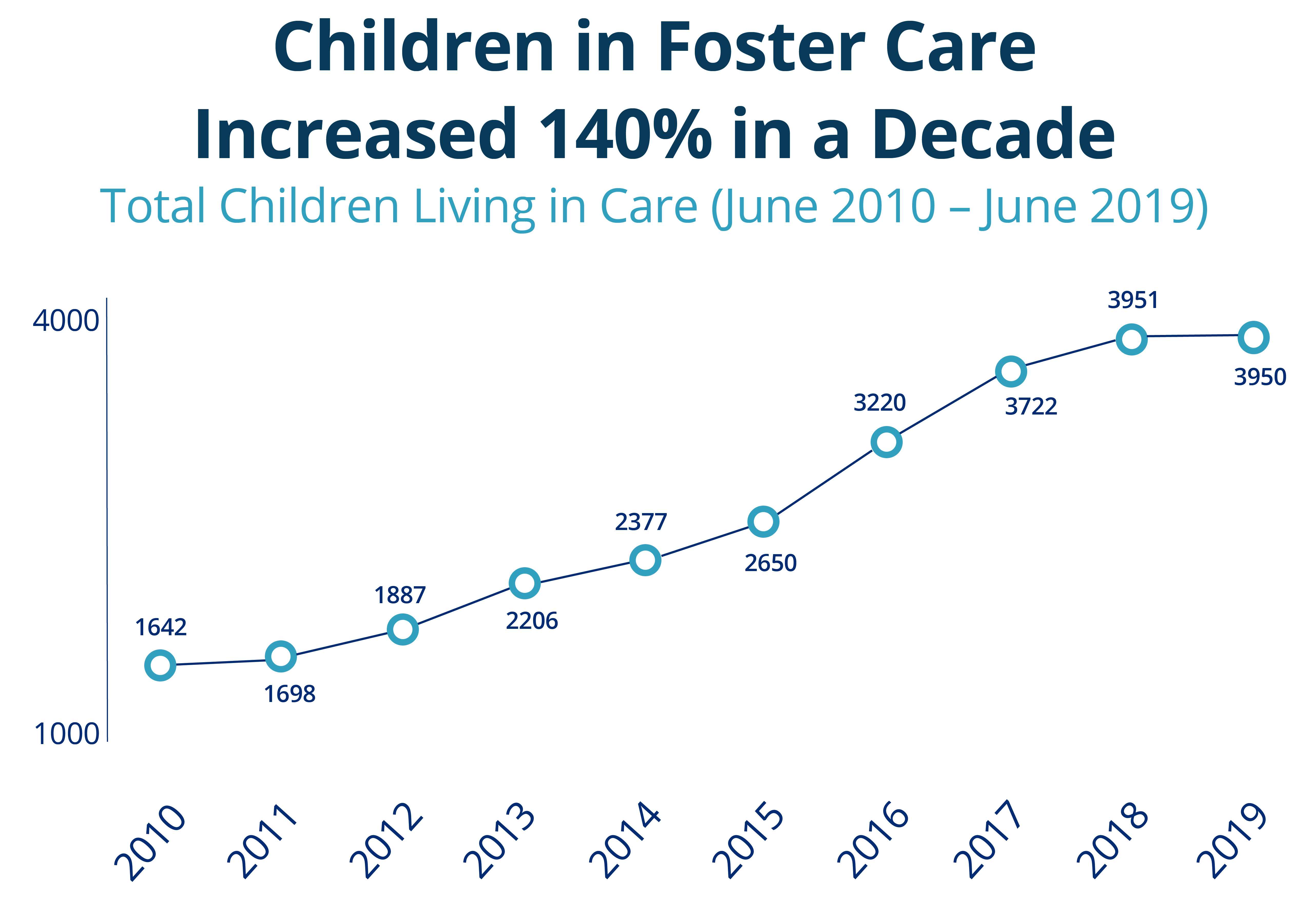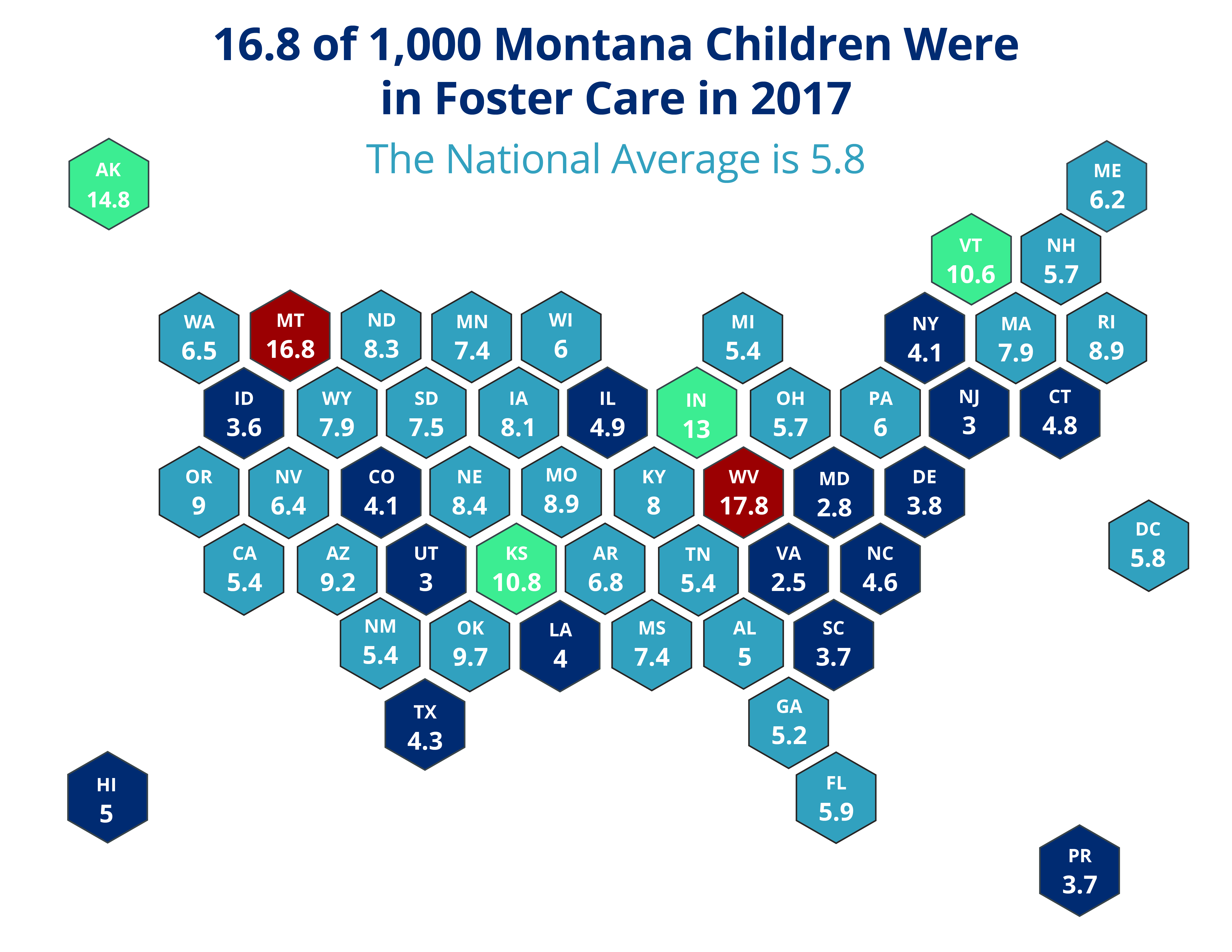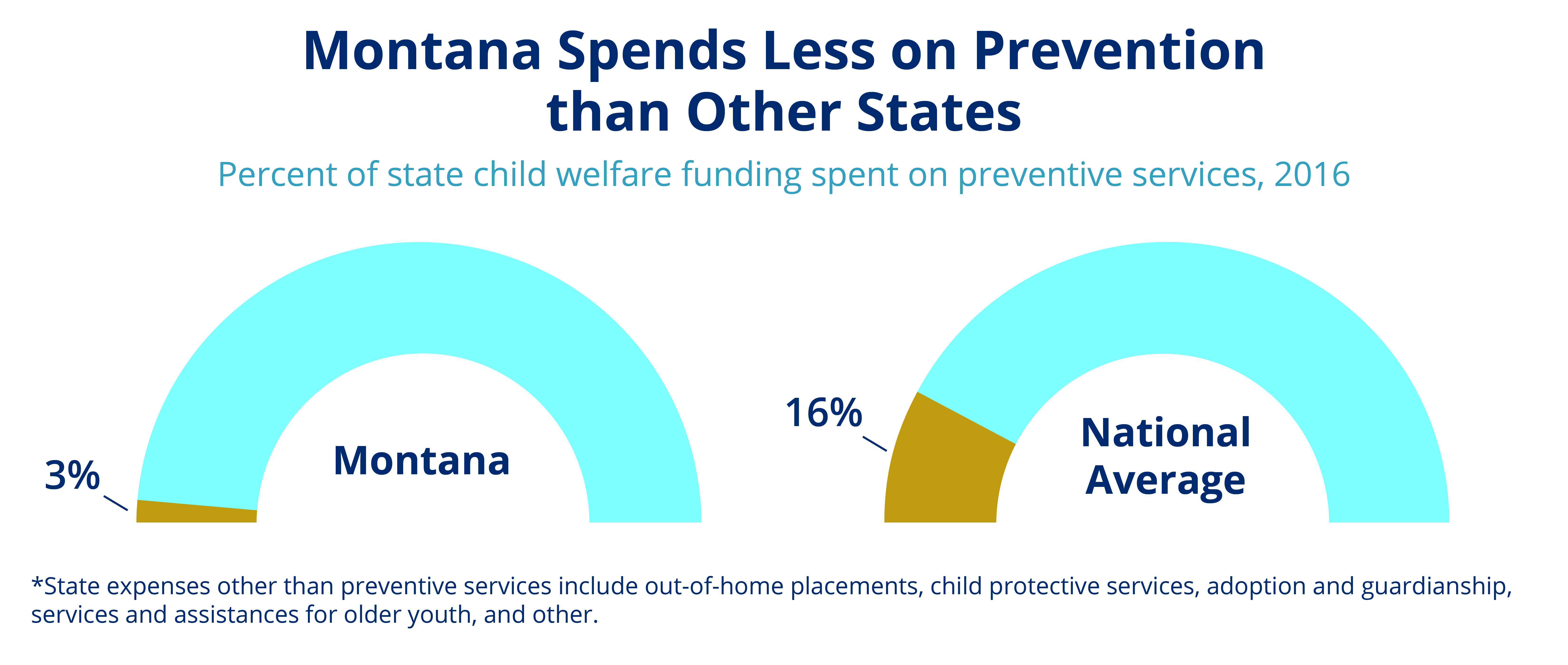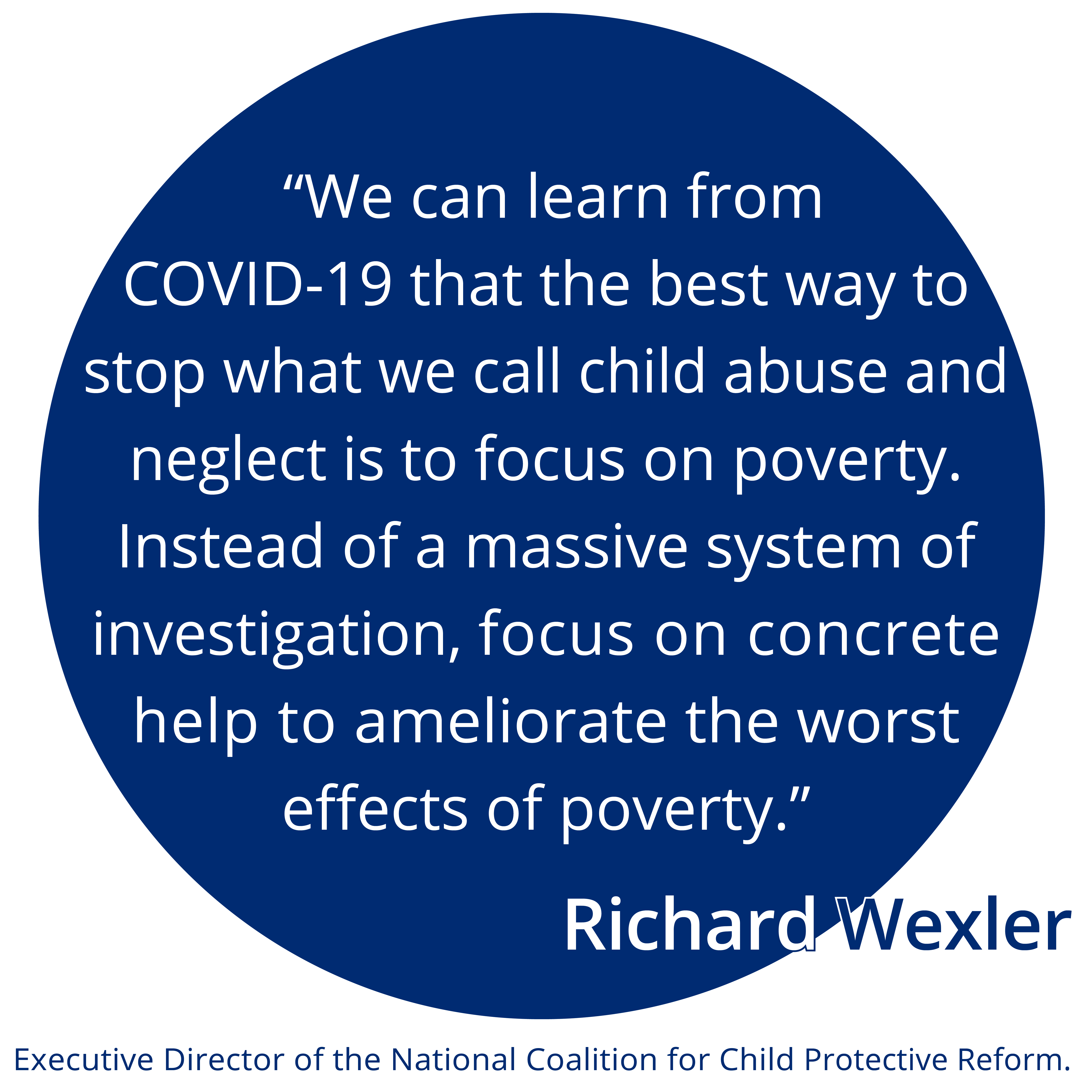The rapid increase in the number of Montana children in foster care or otherwise involved in the child protection system over the past decade has called attention to how our system works and why there are so many vulnerable families and children. The COVID-19 pandemic further elevates the deficiencies in our child protection system. Our system of detecting abuse and neglect relies heavily on teachers, doctors, and other professionals to identify suspected child maltreatment, as well as on a caseworker’s face-to-face contact with families and children. The closure of schools and isolation of families renders the system’s usual tools and reporting methods nearly obsolete. Montana must shift our child protection system to a holistic system of child well-being that has the capacity and resources to work with families before maltreatment is suspected. Investing in prevention, in response to COVID-19 and into the future, will ease the strain on a child protection system that is already struggling to fulfill its broad mandate to both protect children and resolve the underlying issues that destabilize families.
Even prior to COVID-19, Montana had high rates of foster care placement. Montana ranked second in the nation with a removal rate of 16.8 children by 1,000 in foster care as of 2017.[1] Over the past decade, the number of Montana children entering out-of-home care increased at an alarming rate. In FY10, 995 children entered foster care.[2] By FY19, the number of children entering out-of-home care rose to 2,357. As of June 2020, Montana had 3,528 children in the foster care system.[3]
 Due to the legacy of oppression, forced removal of children, and discriminatory policies that continue into the present day, American Indian and Alaska Native children are overrepresented in Montana’s foster care system. American Indian and Alaska Native children make up about 12.3 percent of all children in Montana; however, within the state foster care system, American Indian and Alaska Native children made up 22 percent of the total number of children in care between 2015 and 2019.[4] Throughout the 19th and 20th centuries, federal and state governments systematically removed American Indian children from their families and communities, which continued genocide by way of destroying the family unit and erasing identity. Today, the standards for removing a child from their home remain unequal and inconsistently applied in cases involving American Indian families. American Indian families are the most likely to have their children removed from the home as the first step by caseworkers and the least likely to be offered supportive interventions to keep the family together.[5]
Due to the legacy of oppression, forced removal of children, and discriminatory policies that continue into the present day, American Indian and Alaska Native children are overrepresented in Montana’s foster care system. American Indian and Alaska Native children make up about 12.3 percent of all children in Montana; however, within the state foster care system, American Indian and Alaska Native children made up 22 percent of the total number of children in care between 2015 and 2019.[4] Throughout the 19th and 20th centuries, federal and state governments systematically removed American Indian children from their families and communities, which continued genocide by way of destroying the family unit and erasing identity. Today, the standards for removing a child from their home remain unequal and inconsistently applied in cases involving American Indian families. American Indian families are the most likely to have their children removed from the home as the first step by caseworkers and the least likely to be offered supportive interventions to keep the family together.[5]
In Montana, funding for child protective services provided by the Child and Family Services Division (CFSD) of the Department of Public Health and Human Services (DPHHS) comes from a combination of federal and state dollars. In FY16, Montana’s total child welfare spending was $81 million, but Montana uses its federal and state funds differently than the national pattern. Montana spends 41 percent of federal funds and 37 percent of state funds on foster care placements. Montana spends 2 percent of federal funds and 3 percent of state funding on prevention services, as compared to the 13 percent and 16 percent spent on average by other states.[6] Before the pandemic, Montana was in the early stages of implementing the 2018 federal Family First Prevention Services Act (FFPSA). The FFPSA allows states to use Title IV-E funds, the largest federal funding source for child welfare activities, to pay for services to prevent children from entering foster care. States choosing to implement the prevention program under Families First can be reimbursed for prevention services that meet specific criteria: mental health prevention and treatment; substance abuse prevention and treatment; and in-home parent skill-based programs. Montana received more than $43.8 million through the IV-E program in FY19.[7] The FFPSA provides a new way to address substance abuse and mental health needs that are part of an estimated 65 percent of child removal cases in Montana.[8]
Before the pandemic, Montana was in the early stages of implementing the 2018 federal Family First Prevention Services Act (FFPSA). The FFPSA allows states to use Title IV-E funds, the largest federal funding source for child welfare activities, to pay for services to prevent children from entering foster care. States choosing to implement the prevention program under Families First can be reimbursed for prevention services that meet specific criteria: mental health prevention and treatment; substance abuse prevention and treatment; and in-home parent skill-based programs. Montana received more than $43.8 million through the IV-E program in FY19.[7] The FFPSA provides a new way to address substance abuse and mental health needs that are part of an estimated 65 percent of child removal cases in Montana.[8]
States have the option of delaying implementation of FFPSA. As of May 2020, only five states have approved plans under the FFPSA, but five states and two tribal nations have submitted plans for approval.[9] Montana chose to delay implementation. The DPHHS and CFSD developed a strategic plan to fully enact the FFPSA on or before October 2021.[10] It is not yet determined how much and to which communities and populations Montana will re-direct its Title IV-E funds under the new law.
The 2021 Legislature will be grappling with budget shortfalls caused by COVID-19, and Montana risks seeing major cuts to its child protection system in response to declining state revenue. We cannot rely solely on federal funding to invest in prevention. While FFPSA is a promising step towards reforming our child welfare system, Families First reallocates existing money and does not put forth additional financial support to grow the overall funding available. The current economic and public health crisis, and accompanying hardships families face, threaten to take a severe toll on our families. Montana cannot ensure the safety of its children without increasing its investment in prevention.
The mission of CFSD is to make sure children are kept safe and, if a family is already in crisis, to help stabilize that family so that children can live safely at home, whenever possible. With Montana’s child protection system stretched to capacity, it is imperative that Montana strengthens its child abuse prevention efforts to reduce the incidence of child maltreatment and decrease the number of families that become involved in the child protection system in the first place.
Staffing levels of the child protection workforce are not commensurate with the duties and stress of the job. Child protection workers serve more children than what national standards recommend. While the recommended caseload for caseworkers is 12 to 15 children, more than half of CFSD regional office hub staff reported caseloads of 20 to 39 children per worker.[11] When positions go unfilled, remaining caseworkers must add to their caseloads, which adds yet another layer of stress on remaining workers already stretched thin.
Montana’s annual turnover rate for caseworkers is estimated at 40 percent. For comparison, turnover is significantly lower in surrounding states, with Idaho seeing 19 percent turnover, South Dakota seeing 27.7 percent turnover, and North Dakota seeing 23.4 percent turnover.[12] Such a high rate of turnover impacts everyone involved. High turnover reflects the stress, criticism, and secondary trauma caseworkers face in their jobs, which leads to burnout. High turnover means that CFSD must conduct job searches, interview, and train new staff, which requires more time and resources to handle the revolving door of caseworkers. Both families and the service providers who help with in-home services, such as home management skill training, parenting education classes, and supervised visitations, can experience great difficulty trying to contact caseworkers when ongoing cases are passed off from one caseworker to another.[13] Court deadlines may be extended, which prolongs family reunification or the resolution of cases. A history of poor communication and cross-cultural training among state caseworkers and tribal child protection workers has led to poor outcomes for children protected under the Indian Child Welfare Act.[14] These pressures on our child protection workers prevent Montana from focusing on prevention because the workforce must focus on cases that require immediate action.
Adhering to social distancing guidelines is necessary to flatten the curve of COVID-19. Taking these steps comes with a ripple effect. Even though COVID-19 presents unprecedented challenges, history tells us that the pandemic’s economic fallout will increase the number of people living in poverty who will struggle to afford rent, food, and child care. Across Montana, 30  percent of children live in homes where parents lack secure employment, making these families particularly vulnerable to an economic downturn.[15] Stress, isolation, and unemployment are major factors associated with abuse or neglect. When there is already child maltreatment occurring in the home, a public health and economic crisis adds to these existing stressors and can change parental behavior.
percent of children live in homes where parents lack secure employment, making these families particularly vulnerable to an economic downturn.[15] Stress, isolation, and unemployment are major factors associated with abuse or neglect. When there is already child maltreatment occurring in the home, a public health and economic crisis adds to these existing stressors and can change parental behavior.
Families are under significant pressure right now, balancing work and parenting, and many find that they are suddenly without employment. Families already working hard at low-paying jobs are at risk of losing the resources they need to support themselves and provide for their children. Analysis shows that a social crisis or natural disaster disrupts families’ lives and exacerbates risk factors for child maltreatment.[16] After the Great Recession, for example, a study of 9-year-old children and their families found that economic distress, job loss, and home foreclosure were linked to parenting behaviors associated with reports of suspected child maltreatment.[17] More analysis into the Great Recession found that reported cases of child neglect increased due to spiking unemployment following the financial crisis. The increases in cases remained even after the economy began to rebound.[18]
Early analysis of the impact of COVID-19 finds that this pandemic will cause the most severe recession in Montana since World War II. Estimates of the economic downturn now project a loss of 75,000 jobs over the year 2020 for the Montana economy and a shortfall in state personal income of $6.4 billion.[19] In the first full week of unemployment filings related to the COVID-19 shutdown, 14,704 Montanans filed new claims. By March 28, 2020, another 19,540 Montanans filed unemployment claims. By comparison, during the highest week for unemployment claims during the Great Recession, 3,837 Montanans filed for unemployment.[20] It remains unknown how long the COVID-19-caused recession will last and how quickly our country will recover. It is clear, though, that lost jobs and lost wages mean that more families will struggle with the burden of financial insecurity and have urgent needs that need to be addressed.
Our existing child protection system relies on in-person institutions that children interact with daily, particularly schools. The majority of reports to the child abuse hotline come from mandatory reporters, including school personnel, doctors, therapists, and law enforcement. These professionals that are obligated to file reports of suspected maltreatment were suddenly cut off from face-to-face interaction.[21] Now that schools across Montana transitioned to remote learning and child protection workers transitioned to home visits online, there is concern about the continued learning, health, and safety of youth. Keeping children at home and away from school or child care services can prevent children from asking for help from someone they trust. Before the pandemic, someone outside the home might notice signs of maltreatment, but amid social distancing, oversight is lost.
One of the immediate impacts of the COVID-19 pandemic is that fewer people call the child abuse and neglect hotline. According to data released by DPHHS, from March 16 to May 20, calls reporting suspected child maltreatment dropped by 27 percent from the same period in 2019.[22] It is concerning that the number of calls fell during the spring, typically a busy season for referrals. However, this decrease is an unfortunate but predictable outcome when fewer mandatory reporters have face-to-face contact with children, making maltreatment more likely to go undetected.[23] The pandemic makes it clear that we must put more resources toward prevention and reform a child protection system that long prioritized intervention and relied on mandatory reporters to identify suspected child maltreatment.
American Indian children and families face greater barriers to reporting when handling cases protected by the Indian Child Welfare Act (ICWA), which sets federal requirements for dependency and neglect cases involving American Indian children and protections for American Indian families. ICWA’s provisions use more stringent legal standards for family preservation, reunification, and termination of parental rights than for other children. These standards are meant to correct historical child removal practices that led to today’s overrepresentation of American Indian children in foster care. The CFSD database does not automatically track ICWA cases. Poor understanding of ICWA requirements among state workers and a lack of established relationships between state workers and tribal partners contribute to the American Indian children’s disparity in state foster care.[24]
A child protection system should include a complete continuum of services to support healthy, resilient families. Below are recommendations to reform our system and, ultimately, reduce the number of children in foster care.
Conclusion
Removing children from their families and homes is traumatic, regardless of the conditions contributing to their removal, and should be avoided whenever possible. The pandemic allows Montana the opportunity to reorient its child protection system, one designed to intervene when families are already in the system, to one that supports families before a crisis. Investing in proactive and preventive measures is the most effective strategy to support healthy, functioning families and reduce child maltreatment.

MBPC is a nonprofit organization focused on providing credible and timely research and analysis on budget, tax, and economic issues that impact low- and moderate-income Montana families.